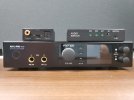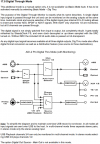I measure-checked 2 digital Toslink devices :
Toslink switch + Bi-directional TosLink/Coaxial SPDIF converter
View attachment 310509
I needed to extend my digital inputs capacity for home living room and another location.
So I purchased
- a 3 inputs - 1 output small TosLink switch - with remote. (30€ - Audiophonics)
- a bi-directional Coaxial/TosLink SPDIF converter (26€ - Amazon.fr)
Both are pure digital SPDIF devices.
No DAC or ADC here.
As you may see on the picture, those are VERY small devices.
Even the remote is tiny, compared to the XLR connector that holds it straight.
View attachment 310511
The TosLink switch has 3 inputs and 1 output.
Input may be selected through the remote or the front switch.
The Coaxial/TosLink SPDIF converter has a coaxial SPDIF (RCA connector) and a Toslink on both sides: Inputs on one side, outputs on the other side.
A switch allows to select which of the 2 inputs you play from.
Both outputs are then receiving the signal (More on that later)
Both devices are powered with 5V and come with corrsponding USB connector.
The convertor came with a 5V adaptor, but with a US plug, so not really usable for me.
I wanted to validate those devices for transparency.
So I've set-up some measurements using a RME UCX II (digital source) and the RME ADI-2/4 Pro SE.
As Amir is doing, I measured performance on the analog side, after the DAC receives the digital signal through the device I wanted to test.
If they are transparent, we should see no difference in measurements.
1. Testing with the RME ADI-2/4 Pro SE as a DAC
First, I've performed measurement with my ussual tool, the RME ADI-2/4 Pro SE as a DAC
I measured the analog loopback (DAC + ADC) of the RME ADI-2/4 Pro SE when fed with a digital signal coming through those devices.
Warning: This will be boring !
So you may want to jump to the next paragraph directly
 SINAD
SINAD
Because I wanted to check the functionality, all SINAD tests here were perfomed at
192kHz.
First, through the
TOSLink switch
NB: I tested the 3 inputs, and there is no difference
View attachment 310514
Then through the
Coaxial>TosLink SPDIF converter
View attachment 310515
Then the same converter but in the other direction:
TosLink > Coaxial SPDIF Converter
View attachment 310517
And, in case you were wondering, the
RME ADI-2/4 with SPDIF input (analog loopback)
View attachment 310518
Jitter
To save some time, I cascaded the 2 devices:
> SPDIF Coax >
Coaxial/TosLink SPDIF converter > TosLink >
TosLink Switch > TosLink > RME ADI-2/4
View attachment 310521
then
> TosLink >
TosLink Switch > TosLink >
Coaxial/TosLink SPDIF converter > Coaxial SPDIF > RME ADI-2/4
View attachment 310522
Multitone
Multitone tests were performed at 192kHz.
Same here
> Coaxial SPDIF >
Coaxial/TosLink SPDIF converter > TosLink >
TosLink Switch > TosLink > RME ADI-2/4
View attachment 310585
Then
> TosLink >
TosLink Switch > TosLink >
Caoxial/TosLink SPDIF converter > Coaxial SPDIF > RME ADI-2/4
View attachment 310586
Just perfect.
I told you this would be boring  2. Testing with the Topping E30 II Lite as a DAC
2. Testing with the Topping E30 II Lite as a DAC
I've been challenged on the fact that the RME is almost a "perfect" tool.
So there is a risk the test is not relevant, since the RME would fix any issue with the incoming digital signal.
That looked like a valid concern.
So I took a DAC I had at hand that I knew had some issue with Jitter on SPDIF input:
The
Topping E30 II Lite I reviewed
here.
So... here we go again.
This time I started with
Jitter measurement
Direct input in the DAC
RME ADI-2/4 Pro SE optical output > TosLink > Topping E30 II Lite > Analog output (L) > RME ADI-2/4 Pro SE
As you may see in the
Topping E30 II Lite review, Jitter performance on SPDIF has some issue.
Not catastrophic;, but not stellar either.
First, for reference, with none of the devices we want to test in the loop.
Here, I kept the measurement of the highest secundary peak, to allow some comparison.
NB: This figure doesn't mean much by itself - don't compare it to a SINAD value !
View attachment 310591
Through the
Coaxial/TosLink SPDIF converter
> Coaxial SPDIF >
Coaxial/TosLink SPDIF converter > TosLink > Topping E30 II Lite > Analog output (L) > RME ADI-2/4
View attachment 310592
Here, we see a difference ! And this is not good.
The second peak (and all other peaks) raised by almost
12dB.
Is that a concern ? I don't know.
Let's try the other direction
(More important, since that's the one I, personnaly, plan to use

)
> TosLink >
Coaxial/TosLink SPDIF converter > Coaxial SPDIF > Topping E30 II Lite > Analog output (L) > RME ADI-2/4
View attachment 310593
In that direction, we have less degradation of the result.
At least that's good.
It's still an average result, but it didn't become much worse than what the DAC can do.
Through the
TosLink switch
> TosLink
> TosLink Switch > TosLink > Topping E30 II Lite > Analog output (L) > RME ADI-2/4
View attachment 310594
Same here.
Not worse than what the DAC can do.
SINAD measurement
Let's check the impact of this on SINAD, if any.
(As above, SINAD measurements here are at 192kHz)
Direct input in the DAC
RME ADI-2/4 Pro SE optical output > TosLink > Topping E30 II Lite > Analog output (L) > RME ADI-2/4 Pro SE
View attachment 310573
Our reference here.
Through the
Coaxial/TosLink SPDIF converter
> Coaxial SPDIF >
Coaxial/TosLink SPDIF converter > TosLink > Topping E30 II Lite > Analog output (L) > RME ADI-2/4
View attachment 310574
Not much impact.
Let's try the other direction
> TosLink >
Coaxial/TosLink SPDIF converter > Coaxial SPDIF > Topping E30 II Lite > Analog output (L) > RME ADI-2/4
View attachment 310575
A bit more distortion, maybe. Still excellent.
Through the
TosLink switch
View attachment 310576
We see again a slight decrease in performance.
That remains very good, though.
Interestingly, the performance here degrades in the opposite direction than the Jitter above.
Why ? No clue.
Multitone measurement
Direct input in the DAC
RME ADI-2/4 Pro SE optical output > TosLink > Topping E30 II Lite > Analog output (L) > RME ADI-2/4 Pro SE
View attachment 310577
That's our reference.
Through the
Coaxial/TosLink SPDIF converter
> Coaxial SPDIF >
Coaxial/TosLink SPDIF converter > TosLink > Topping E30 II Lite > Analog output (L) > RME ADI-2/4
View attachment 310578
Same thing: a bit more noise, but result remains excellent
The other direction
> TosLink >
Coaxial/TosLink SPDIF converter > Coaxial SPDIF > Topping E30 II Lite > Analog output (L) > RME ADI-2/4
View attachment 310579
Nothing to complain about
Through the
TosLink switch
> TosLink
> TosLink Switch > TosLink > Topping E30 II Lite > Analog output (L) > RME ADI-2/4
View attachment 310580
A bit degraded still, but anyway still very very good.
We have seen some degradation with using a less performant device.
The Jitter test - which was meant to be very sensible to Jitter and other digital domain issues - shows some degradations, for the SPDIF converter (especially in the direction from Coaxial to TosLink).
Nevertheless, that doesn't really show in any of our classical analog measurements, which all score very good.
So it's probably benign.
3. Functionality
ADAT capabilities
Following a question of
@Blumlein 88 , I'm happy to say that
the small switch also works with 8 channels ADAT @48kHz
I've done a quick setup as follows:
PC generator > to 8 Dante channels (Dante controller) > to 8 ADAT output channels (RME 12Mic-D routing) > TosLink > TosLink switch > TosLink > UCX II
And we see the 8 channels in TotalMix
Port replicator capability of the SPDIF converter
The convertor always has both its outputs active.
When feeding the Coaxial/TosLink SPDIF converter with a TosLink input at 192kHz, the Coaxial output works perfectly, but the TosLink output's clock sometimes gets out of sync.
I didn't experience this issue at 44.1kHz, 48kHz and 96kHz though.
So it's acting perfectly as a converter, but it may give some issue to duplicate the output at high sampling frequency.
4. Conclusion
This review I thought would be quick and easy, and at the end, it took me almost the whole day...
But we learned a few interesting things.
After testing with the RME only, I wrote
"Those devices are adding or substracting nothing to the signal they receive".
After further look and check with the more Jitter-sensitive (and way cheaper) Topping E30 II Lite, this is not absolutely true.
There are measurable performance degradations.
I still think we may trust those devices to do exactly what you want them to do.
So I would rate them as
Good for the job
(with this specific config)
Also, it's important to note that, even if those devices are not perfect, they absolutely don't prevent a well engineered device to perform perfectly through them.
So that's not -not only- those devices' "fault" if the Topping is giving some lower results with them.
Good engineering is not only about good raw figures.
It also gives you more freedom.














